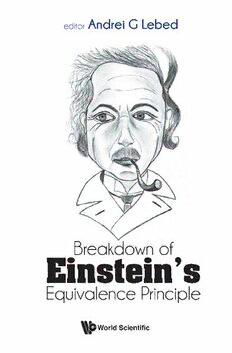Table Of ContentB1948 Governing Asia
TTTThhhhiiiissss ppppaaaaggggeeee iiiinnnntttteeeennnnttttiiiioooonnnnaaaallllllllyyyy lllleeeefffftttt bbbbllllaaaannnnkkkk
BB11994488__11--AAookkii..iinndddd 66 99//2222//22001144 44::2244::5577 PPMM
Published by
World Scientific Publishing Co. Pte. Ltd.
5 Toh Tuck Link, Singapore 596224
USA office: 27 Warren Street, Suite 401-402, Hackensack, NJ 07601
UK office: 57 Shelton Street, Covent Garden, London WC2H 9HE
British Library Cataloguing-in-Publication Data
A catalogue record for this book is available from the British Library.
BREAKDOWN OF EINSTEIN’S EQUIVALENCE PRINCIPLE
Copyright © 2023 by World Scientific Publishing Co. Pte. Ltd.
All rights reserved. This book, or parts thereof, may not be reproduced in any form or by any means,
electronic or mechanical, including photocopying, recording or any information storage and retrieval
system now known or to be invented, without written permission from the publisher.
For photocopying of material in this volume, please pay a copying fee through the Copyright Clearance
Center, Inc., 222 Rosewood Drive, Danvers, MA 01923, USA. In this case permission to photocopy
is not required from the publisher.
ISBN 978-981-125-358-4 (hardcover)
ISBN 978-981-125-359-1 (ebook for institutions)
ISBN 978-981-125-360-7 (ebook for individuals)
For any available supplementary material, please visit
https://www.worldscientific.com/worldscibooks/10.1142/12759#t=suppl
Typeset by Stallion Press
Email: [email protected]
Printed in Singapore
YYoonnggQQii -- 1122775599 -- BBrreeaakkddoowwnn ooff EEiinnsstteeiinn EEqquuiivvaalleennccee PPrriinncciippllee..iinndddd 11 99//99//22002222 44::4466::0088 ppmm
September12,2022 11:21 BreakdownofEintein’sEquivalencePrinciple-9inx6in b4567-fm pagev
The editor dedicates his own contributions to the book to his wife,
Natalia, for her loving support and patience.
v
B1948 Governing Asia
TTTThhhhiiiissss ppppaaaaggggeeee iiiinnnntttteeeennnnttttiiiioooonnnnaaaallllllllyyyy lllleeeefffftttt bbbbllllaaaannnnkkkk
BB11994488__11--AAookkii..iinndddd 66 99//2222//22001144 44::2244::5577 PPMM
September12,2022 11:21 BreakdownofEintein’sEquivalencePrinciple-9inx6in b4567-fm pagevii
(cid:2)c 2023 World Scientific Publishing Company
https://doi.org/10.1142/9789811253591 fmatter
Preface
From a historical point of view, the Equivalence Principle was first clearly
formulated by Galileo Galilei (see Fig. 1) as the independence of a body’s
accelerationin the Earth’s gravitational field on the body’s mass. Accord-
ing to the popular legend, he dropped cannonballs of different sizes from
the Leaning Tower of Pisa and found that they hit the groundat the same
time. This wasapproximately400–450yearsago. Usingmodernlanguage,
Galilei established the equivalence of inertial, m , and gravitational, m ,
i g
masses with the accuracy about |m −m |/m ≤ 2×10−2. Much less is
i g i
knownabouthispredecessor,GreekphilosopherJohnPhiloponus,whoper-
formedlesssophisticatedbutsimilarexperimentsapproximately1500years
ago. Newtonian physics accepted Galileo’s Equivalence Principle and the
first successful theory of gravity, created by Isaac Newton, explained the
mainfeaturesofourplanetarysystem,includingtheempiricalKeplerlaws.
In 1916, Albert Einstein (see Fig. 2) published his theory of General
Relativity, which is based on Einstein’s Equivalence Principle. Before he
elaborated General Relativity, in 1911, he had formulated the Equivalence
Principle in the following way. Einstein considered two reference frames,
K and K(cid:2), where K was placed in a uniform gravitational field. K(cid:2) was
not in a gravitational field, but it was uniformly accelerated. He wrote:
“As long as we restrictourselvesto pure mechanical processesinthe realm
where Newton’s mechanics holds sway, we are certain of the equivalence
of the systems K and K(cid:2). But this view of ours will not have any deeper
significance unless the systems K and K(cid:2) are equivalent with respect to
all physical processes, that is, unless the laws of nature with respect to
K are in entire agreement with those with respect to K(cid:2). By assuming
this to be so, we arrive at a principle which, if it is really true, has great
heuristic importance. By theoretical considerationof processes which take
vii
September12,2022 11:21 BreakdownofEintein’sEquivalencePrinciple-9inx6in b4567-fm pageviii
viii Preface
Fig.1. GalileoGalilei(1564–1642) (drawingofNataliaLebed).
Fig.2. AlbertEinstein(1879–1955) (drawingofNataliaLebed).
September12,2022 11:21 BreakdownofEintein’sEquivalencePrinciple-9inx6in b4567-fm pageix
Preface ix
placerelativelytoasystemofreferencewithuniformacceleration,weobtain
information as to the career of processes in a homogeneous gravitational
field.”
Wenotethatmodernphysicsdistinguishesbetweenthreevariantsofthe
Equivalence Principle: weak Equivalence Principle, Einstein’s Equivalence
Principle, and strong Equivalence Principle. The weak Equivalence Prin-
ciple is equivalent to the so-called universality of a free fall and is related
to the original Galileo experiments. This variant has been confirmed with
greataccuracyfor ordinarysolid-state bodies. In the recentspace mission,
MICROSCOPEoftheFrenchspaceagencyCNES,theexperimentalequip-
mentconsistedoftwocylindricalshells: largercylindricalshellandsmaller
one. The smaller shell, made of platinum and rhodium, was placed inside
the largerone, made of titanium andaluminum. In more than 2 years and
5 months, physicists on the Earth observed a relative motion of the cylin-
ders and found that they were accelerated with the same quantity with
accuracy better than |m −m |/m ≤ 10−16. We can say that the Equiv-
i g i
alence Principle is one of the best established laws in physics. Moreover,
twomorespacemissionsarecurrentlyintheirdesignphases: SatelliteTest
of the Equivalence Principle (STEP) and Galileo Galilei (GG). The STEP
mission is being developed by an international team ofcollaboratorsunder
theleadershipofStanfordUniversity,whereastheGGisanItalianproject.
The missions would be operated in a similar way as the MICROSCOPE
experiment. To improve the accuracyof measurements, the STEP mission
woulduseuptofourpairsofcylindersinsteadofjustonepair. Inaddition,
a tank of liquid helium would keep the temperature of the cylinders con-
stant. The shell masses would also be surrounded with a superconducting
shell. According to theoretical preliminary estimates, the STEP mission
would allow to confirm or to disconfirm the Equivalence Principle with
accuracy |m −m |/m ∼10−18. The peculiarity of the GG space mission
i g i
is that the satellite would quickly spin about its main axis, which provides
the accuracy of the measurements of about |m −m |/m ∼10−17.
i g i
It is easy to understand that a violation of the weak (i.e. Galileo’s)
Equivalence Principle means that Einstein’s Equivalence Principle is also
violated, but the opposite statement is not true. In this book, we consider
such unexpected special situations, where Einstein’s Equivalence Principle
or weak Equivalence Principle are violated from theoretical point of view
and briefly discuss the possible experimental methods to detect such viola-
tions.

